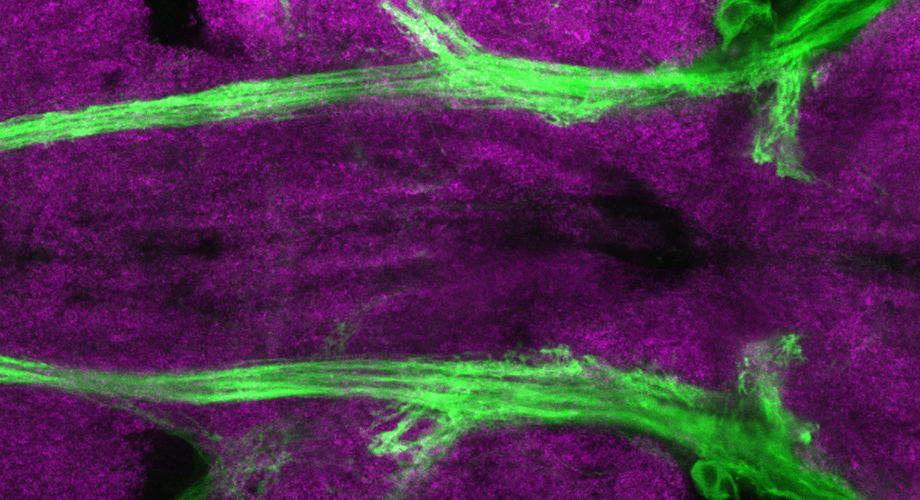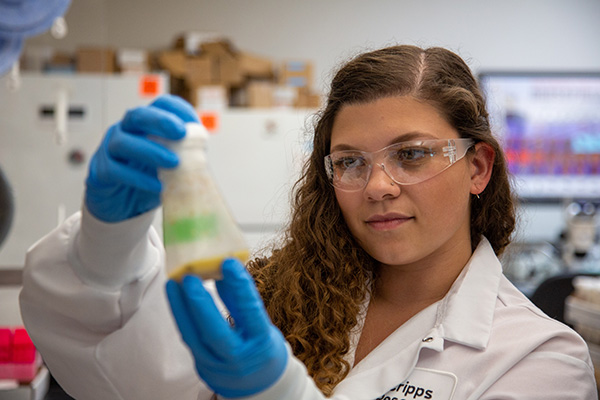
Neurons (green) in the ventral nerve cord of the fruit fly regulate metabolism in NF1 neurofibromatosis fly models. (Photo credit: Tomchik lab.)
Changes in metabolism may produce neurofibromatosis traits, study finds
Research in fruit flies reveals how nerve cell changes disrupt normal metabolic rate.
July 13, 2021
JUPITER, FL—Neurofibromatosis type 1, a disease that features nerve tumors, an elevated risk of autism, and many other symptoms, has long been tied to mutations in a gene called NF1. Scientists at Scripps Research have discovered important clues about how that gene disruption may lead to disease.
The scientists’ findings appear July 13 in the journal Nature Communications. The team led by Seth Tomchik, PhD, an associate professor of neuroscience at Scripps Research, found that in a standard model organism, the Drosophila melanogaster fruit fly, mutating the fly version of NF1 alters the function of a specific population of nerve cells. This in turn leads to widespread metabolic disruptions, including a markedly higher metabolic rate—essentially a faster consumption of energy—in these insects.
The findings dovetail with prior hints of metabolic abnormalities in neurofibromatosis type 1 patients, and suggest the possibility that these abnormalities are key features and drivers of the neurofibromatosis disease process.
“Our findings suggest that we should look at the neuronal regulation of metabolism in people to better understand this disease, and potentially find more effective ways to treat it,” Tomchik says.
Neurofibromatosis type 1 arises when just a single copy of NF1, of the two normally found in cells, is mutated and inactivated. The disorder occurs in one out of every 3,500 or so live births, and currently about 100,000 people in the United States are living with it. Benign tumors that grow from nerves anywhere in the body are one of the classic features of neurofibromatosis type 1, but the disorder can include epilepsy, learning disabilities, vision problems, and skin lesions, along with a higher risk of autism spectrum disorder, cancers, and heart disease.
The protein encoded by the NF1 gene, neurofibromin, normally works, among other things, to regulate the activity of a multifunctional, growth-related protein called Ras. Its disruption leads to more Ras activity. Ras is also hyperactive in many cancers. However, scientists don’t know much more than that about the disease process. The only specific treatment, a drug called selumetinib that was approved by the Food and Drug Administration in 2020, can shrink or prevent the growth of a type of benign nerve tumor, but it is applicable only to a subset of children with the disease, and is not a cure.

Graduate student Valentina Botero is first author on a study of how NF1 mutations disrupt metabolism in fruit flies.
In recent years, studies of neurofibromatosis type 1 in people and in animal models have begun turning up evidence that the disorder also involves abnormalities in metabolism. People who have the disorder are shorter than average and appear to have a relatively low risk of getting type 2 diabetes. Similarly, mice with mutations in the mouse NF1 gene, compared to normal mice, are leaner, and are more resistant to obesity and have high blood sugar levels when given high-calorie diets.
In the new study, Tomchik and his colleagues, including first author Valentina Botero, a graduate student in the Tomchik laboratory, investigated the mechanisms of neurofibromatosis type 1’s metabolic impact with detailed experiments on Drosophila fruit flies—which, despite their evolutionary distance from humans, model many aspects of the human disease.
The scientists showed, using advanced genetic engineering techniques, that when the flies have mutations in their version of NF1, so that levels of fly neurofibromin protein are greatly reduced, their metabolic rate is significantly higher, so that they feed more and burn energy faster, compared to normal flies.
A key discovery was that this and other metabolic alterations in the mutant flies are due mainly to the disruption of fly neurofibromin function in a small set of neurons in the fly ventral nervous system. This means that the nervous system is the root cause of the metabolic changes and pinpoints the precise location, Tomchik says.
The metabolic pathways regulated by these neurons in fruit flies are likely regulated by different sets of neurons in humans, but the basic pathways themselves are found in virtually all animals, Tomchik notes.
“This study certainly has given us an idea of the populations of neurons in people that we should look at in future studies for their potential role in mediating metabolic effects of neurofibromatosis type 1,” he says.
Although the metabolic alterations identified in the study represent a distinct, and so far little-studied, facet of the disease, he adds, they may also contribute to some of the better known signs and symptoms.
He and his team now plan to do more detailed studies of the metabolic pathways affected by NF1 mutations, in animal models and in human cells, to see how the disruptions of those pathways may lead to different manifestations of the disease.
“We’re definitely interested in the possibility of targeting specific metabolic pathways as a way to treat this disorder,” Tomchik says.
Tomchik says the study was a collaboration that included the laboratories of William Ja, PhD, an associate professor in Scripps Research’s Department of Neuroscience; Alex Keene, PhD, a professor of biological sciences at Florida Atlantic University; James Walker, PhD, an assistant professor of neurology at Harvard Medical School; and Kenneth Colodner, PhD, an assistant professor of neuroscience at Mt. Holyoke College.
“Neurofibromin regulates metabolic rate via neuronal mechanisms in Drosophila” was co-authored by Valentina Botero, Bethany Stanhope, Elizabeth Brown, Eliza Grenci, Tamara Boto, Scarlet Park, Lanikea King, Keith Murphy, Kenneth Colodner, James Walker, Alex Keene, William Ja, and Seth Tomchik.
Support for the research was provided by the National Institutes of Health (R01 NS097237, R01 AG045036, R01 NS085152, DC017390, R21 NS096402), the U.S. Department of Defense (NFRP W81XWH-16-1-0220) and the Kanter family.
For more information, contact press@scripps.edu

